TBA120 Series FM Demodulator ICs.
Version 1.00. 29th Sept. 2006.
The TBA120 Series ICs provide a high-gain limiting IF amplifier and a quadrature coincidence detector in one package. These ICs are primarily intended for extraction of TV intercarrier sound, which (in Europe) is frequency modulated onto a 5.5MHz or 6MHz subcarrier. The TV waveform constitutes an extreme interfering signal, and the TBA120 provides superior performance in comparison to early Foster-Seeley and Ratio Detector systems, with a considerable reduction in component count.
TBA120
The equivalent circuit of the original TBA120 (TBA120A, SN76660) is given below. Input to the IF amplifier is at pin 14, with DC bias provided at pin 13. The original intention was that an IF transformer should be connected between pins 13 and 14, but a capacitive or ceramic filter input can be implemented simply by connecting a resistor (Rin) in place of the coil to provide the DC feedback. Typical values for Rin lie between 330Ω and 2.2KΩ, chosen, in the case of ceramic filter input, according to the filter maker's recommendations. The capacitor network between pins 2 and 13 provides AC feedback to stabilise the amplifier.
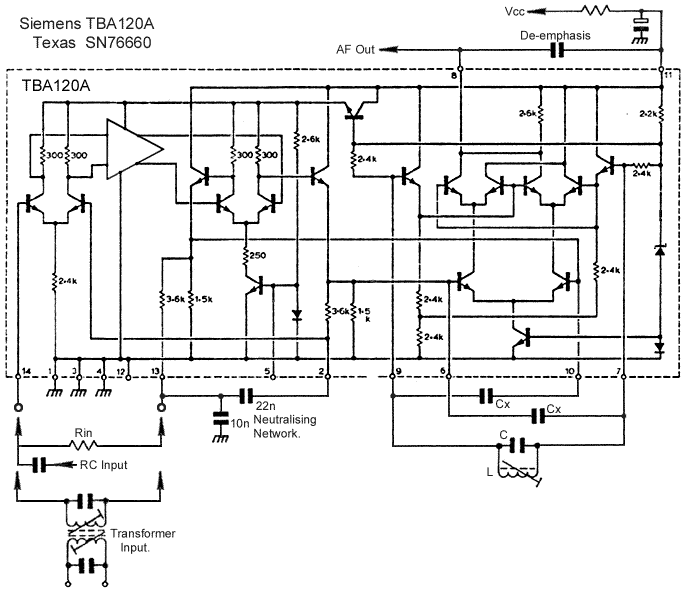
The FM demodulator simply requires an LC resonator and a pair of feedback capacitors (Cx). For 5.5 or 6MHz FM systems, the recommended value for Cx is 50pF, but for lower frequencies a larger value is required. A value of 1nF gives satisfactory NBFM performance at both 455KHz and 100KHz. Manufacturers tend not to quote maximum operating speed, but there seems to be no reason why the IC should not also work (as a wideband FM detector) at 10.7MHz.
| The output at pin 8 follows the familiar S-curve characteristic of FM discriminators. The figure on the right shows a typical S-curve, plotted against a notional IF bandpass characteristic. The actual shape of the IF bandpass plateau is of little importance, since limiting of the IF amplifier occurs with about 30μV input and the system is effectively immune to amplitude fluctuations. The DC component swings about a nominal 7V (for the recommended Vcc = 12V), and can be used, in conjunction with a bridge circuit, to provide a centre-zero tuning meter. Note however, that the DC level drifts with chip temperature, and temperature compensation of the bridge is required if the tuning meter needs to be calibrated on zero within 15 minutes of switch-on. | 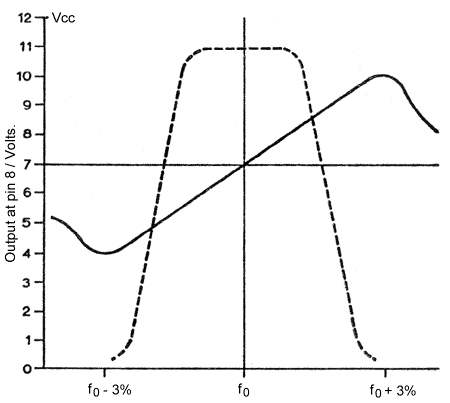 |
The slope of the S-curve depends on the LC ratio and Q of the quadrature circuit resonator. Manufacturers tend not to publish data on this subject, but for NBFM systems the following have been found to work well: From ref. 1; at 455KHz, C = 10nF, L = 50 turns on a 3/16" dia former with slug, gives 200mV audio for 3KHz deviation. From the author's work; at 100KHz, C = 18nF, L = 130 turns pile-wound 32swg on a 3/16" former with slug, gives approx. 1.9V rms for 3KHz deviation. In the example circuits to follow, note that some designers have placed a resistor across the LC circuit to moderate the Q.
TBA120S
The equivalent circuit of the TBA120S, with suitable external components for 5.5MHz use, is shown below. The TBA120S provides additional functionality over the TBA120, in the form of a 12V (nominal) zenner diode at pin 12, an audio amplifier at pins 4 and 3, a remote AF gain control input at pin 5, and internal 50pF quadrature feedback capacitors across pins 9 and 10 and pins 6 and 7. External capacitors can, of course, be added to make the demodulator work at low frequencies as before.
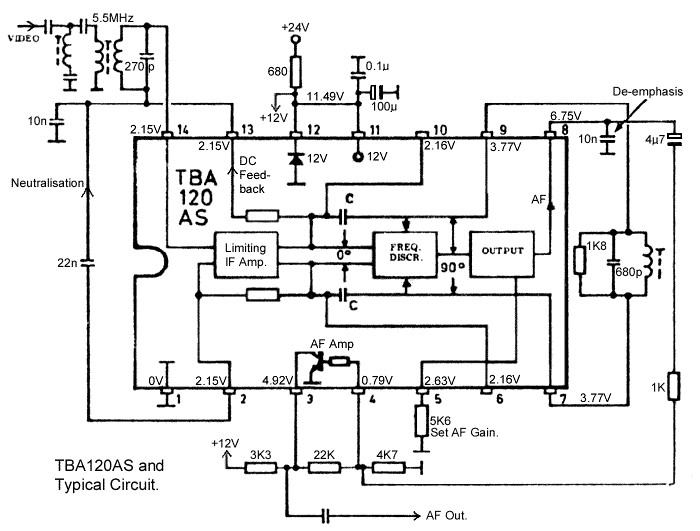
Supply Voltage Range: 6 - 18V.
Input Limiting Voltage (f=5.5MHz, Δf=±50KHz, fmod=1KHz, Q=45): <60μV, 30μV typ.
AF Gain control range (pin 5): >70dB. 75dB typ.
Some TBA120S circuit examples are shown below:
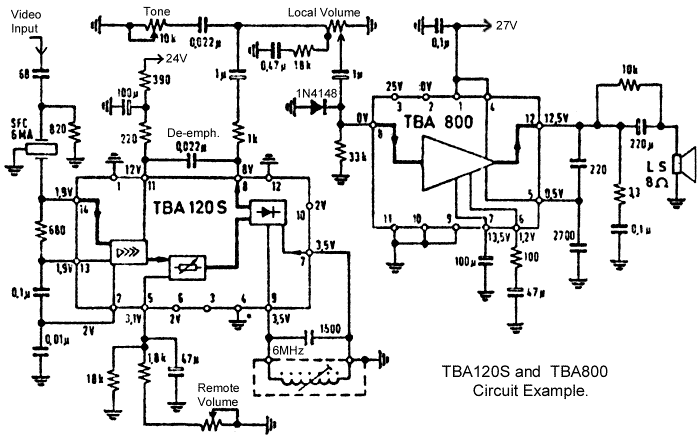
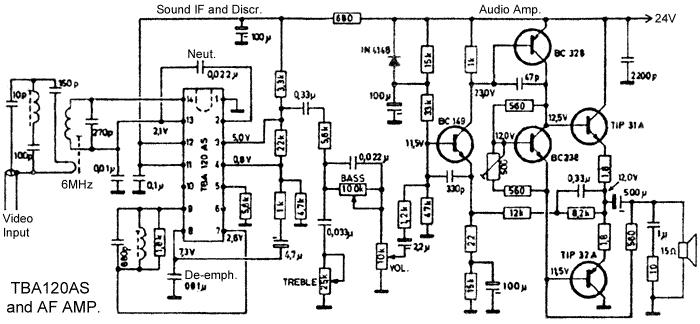
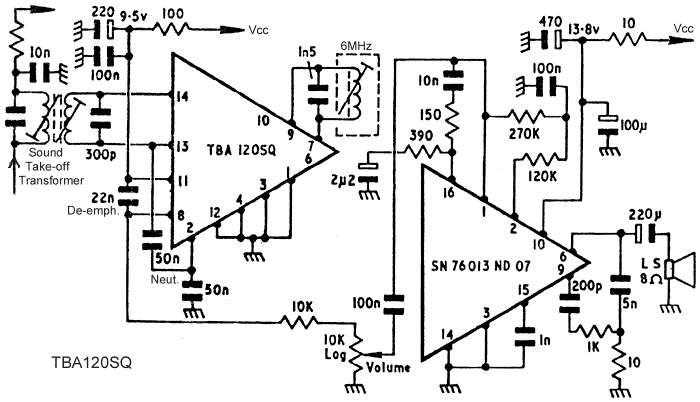
TBA120U
The TBA120U is the currently available version. In this IC, the remote gain control facility has been considerably improved, voltage regulation has been incorporated into the main circuit and pin 12 has become a fixed level audio output, and pin 3 has become an auxiliary AF input (for VCR sound). Its IF and demodulator functionality, and adaptability for LF use, is otherwise unchanged
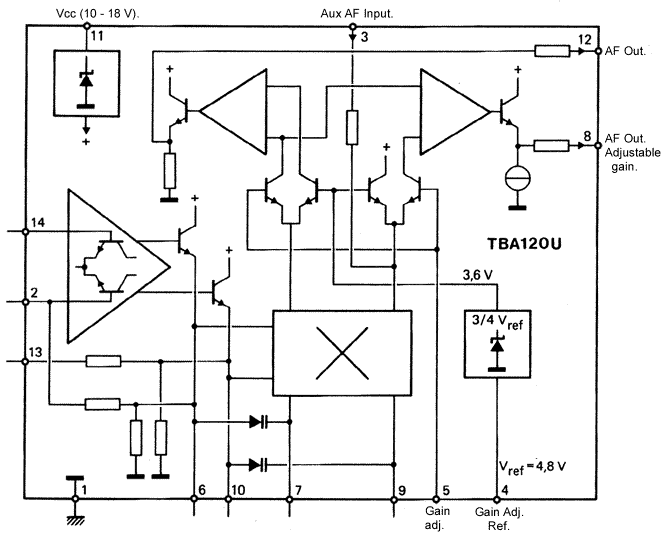
| Supply voltage (pin 11) | 10 - 18V. Rec. 12V. |
| Supply current | 13.5mA typ. |
| IF Voltage gain (5.5MHz) | 68dB typ. |
| Input Limiting threshold | <60μV. 30μV typ. |
| IF input impedance: | 40KΩ // 4.5pF typ. |
| Bypass resistor (pin 13 - 14) | 1KΩ max. |
| AM Suppression (50KHz deviation): | >50dB. 60dB typ. |
| AF output for 50KHz deviation: | 1.2V rms
(pin 8) 1.0V rms (pin 12) |
| Output impedance: | 1KΩ nom. (pins 8 & 12) |
| Supply rejection | 30dB (pin
12) 35dB (pin 8) typ. |
| Gain Adjustment resistor (pins 4 - 5) | 1 to 10 KΩ |
| Gain control range | >70dB, typ. 85dB. |
| Distortion (50KHz deviation, Q=20) | 1% typ. |
| Voltage gain, pin 3 - pin 8 (R5-1=20K) | 7.5 × |
Application circuitry for the TBA120U is given below. Both pins 12 and 8 require de-emphasis capacitors, the values shown being for 50μS. Pins 4 and 5 must be joined together when the remote volume adjustment facility is not used.
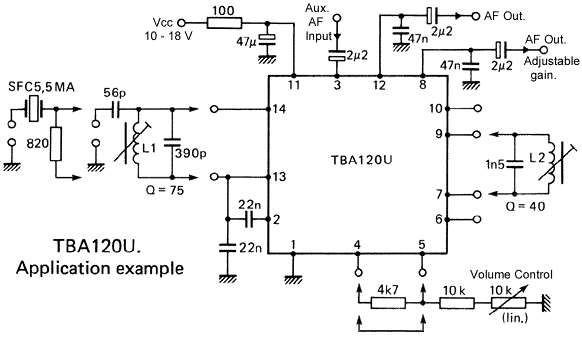
TBA120T
The TBA120T is a version optimised for ceramic input filter and ceramic resonator in the quadrature circuit. The Differences between the TBA120T and TBA120U are shown in the figure below. Note that the TBA120T has an internal 800Ω bypass resistor between pins 13 and 14, and a 500Ω resistor between pins 7 and 9; the latter Q reducing resistor making this IC a poor (but not unworkable) choice if an LC resonator is to be used.
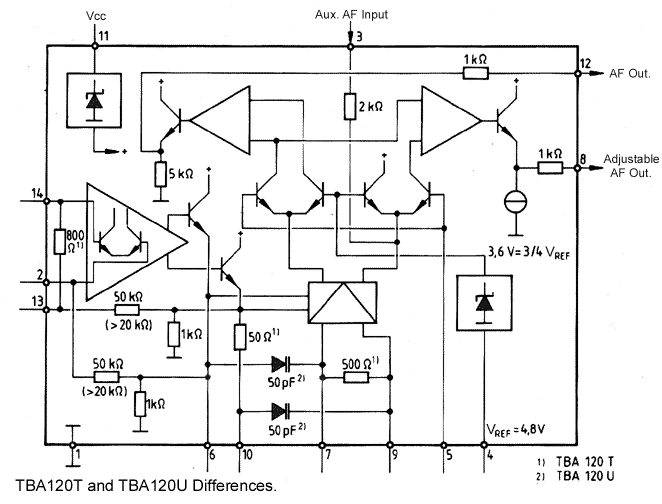
Source Material:
1) J.R.Hey (G3TDZ), "Consumer ICs in Amateur Design", RAD. COM., Sept. 1972.
1a) NBFM Manual, R.S.Hewes (G3TDR) and G.R.Jessop (G6JP), RSGB Publ. 1974
2) Various TV service manuals.
3) A. Franzen, "6MHz TV Sound Demodulator", Elektor, Mar. 1991.
4) Philips Components Technical Handbook, Book 4, Part IC02a, "TV, Video and assoc. systems, Bipolar, MOS", 1989.
5) Telefunken electronic, Selection Guide, Integrated Circuits, 1987.
Additional Information:
"Using the low-cost TBA120 ic device" Tech Topics, Rad Com, Nov 1985, pp860-861.
Subject: Use of the TBA120 as an oscillator + balanced mixer in the LA8AK audio up-converter for tape-recording of high-speed morse. Circuit can also be used as a balanced mixer for SSB generation, or as a product detector.
Suppliers:
Donberg Electronics (electronic parts, including TBA120B,C,S,T,U,UB)